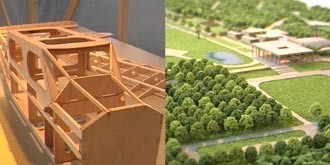Modern according to Simon Starling
The artist Simon Starling discovered functionalism – the Swedish version of the international modernism – through books at home in Glasgow. And despite the years that have passed since then, he still sees its architecture and appending ideas as being somewhat exotic. In his work Project for a modern museum (Moderna Museet, Stockholm), he lets the visitor once again form an opinion on this -ism. To allow for the new encounter to take place, he has created a model to scale of the cemetery – Skogskyrkogården -, a radio-controlled model aeroplane, all combined with the all-observing lens of a video camera. And all from a bird’s-eye view.
Text: ANNIKA HANSSON
Photo & Audio: KRISTOFER SAMUELSSON
Next to the entrance to Moderna Museet, Simon Starling has placed two video screens. These capture everything happening a stone’s throw away, in Moderna Museet’s exhibit room The Vicarage. Here Starling has divided the room into two parts, at once both separated and joined by a milky transparent plastic wall. On one side there is a model to scale of the prime monument of Swedish functionalism, the cemetery Skogskyrkogården just south of Stockholm. On the other side is the work-table used by Kurt Mellander, a retired engineer who is building a model of a radio-controlled aeroplane. Kurt Mellander will be working in The Vicarage during the whole period the exhibit is open.

One camera captures Kurt Mellander building the plane, while the other observes the model of the cemetery. When the plane is ready and when the snow has melted away in the spring, this plane will carry a video camera and fly over Skogskyrkogården. Starling’s installation thus indicates what will happen six months from now at the same time as registering the current work being done – two inseparable perspectives on a work of art in SIMON STARLING Starling’s concept.
In Starling’s works the references to the physical objects leap back and forth, and to and from the ideas behind them. He grasps them quickly and agilely with modernism supplying the backdrop. There’s the aeroplane – an expression of new, modern life, the new transportation techniques, but also of the celestial ascension that death represents. That is why Skogskyrkogården, the cemetery, is also included; it serves as a symbol of death but also of modernist architecture, functionalism intervening in life and death. The final part is the camera – modern photographic techniques, the observing and documentary aspect, the swift movement of the modern age caught on film.
HEAR SIMON STARLING ON (RealAudio):
THE PROJECT
THE FILM
THE CHANGE OF ATTITUDES
WORK IN PROGRESS

A characteristic feature of Starling’s production is the fact that he shows the work, the actual craftsmanship, leading up to the work of art. Usually he is the one casting the metal, chopping down the trees, or putting together a vessel, before subsequently destroying the created objects in a carefully planned process. This time, however, Kurt Mellander has taken his place. So, who knows, perhaps the plane will survive its expedition over Skogskyrkogården?
The starting point for this whole project was Starling’s infatuation with Swedish functionalism – the northernmost version of international modernism. In Sweden this style of architecture, and the ideas surrounding it regarding light, air, and functionality for everyone, had its major break-through at the Stockholm Exposition in 1930. Gunnar Asplund came to be one of its leading architects. The Swedish Welfare State was to be characterised by efficiency, comfort and functionality, and with the construction of Skogskyrkogården death was viewed from a similar perspective.
In Starling’s works associations are presented freely and playfully, as if in a boyhood fantasy. The themes involved, however, are far heavier. The dreams of aeroplanes, of enchanting architecture, of the good new age, become peculiarly contradictory in Starling’s hands.
